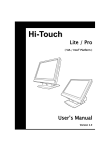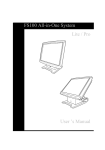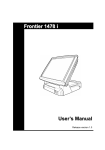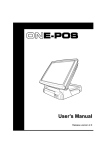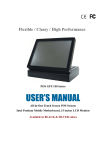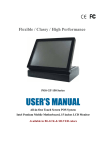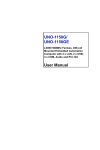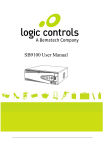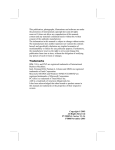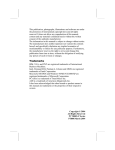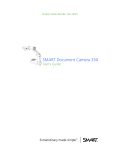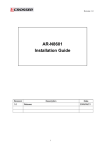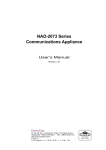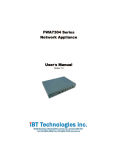Download Smart Kiosk SKI-120 / SKI-150 User`s Manual
Transcript
Smart Kiosk SKI-120 / SKI-150 User’s Manual Revised version 1.0 Preface About this Manual Thank you for purchasing our Smart Kiosk Terminal. This terminal offers highly enhanced features, with easy connection to various optional devices for optimal performance. This user manual describes how to setup and connect your terminal. Copyright © Copyright 2007 All rights reserved. This product and related documentation are protected by copyright and are distributed under licenses restricting their use, copying, and distribution. No part of this documentation may be reproduced in any form by any means without prior written authorization of the manufacturer and its licensors, if any. Safety notices Before You Proceed • Read the safety notices and the User Manual carefully before using the product. • Keep the box and packaging in case the product needs to be shipped in the future. • Follow the product and warning label instructions. • Any changes or modifications that do not follow the instructions in this manual will void this productʹs warranty. Power Supply Safety Notes • To avoid electric shocks, disconnect the power cord from the electrical outlet before relocating the system. • Make sure the voltage of the power outlet conforms within voltage range of the terminal. Failure to comply may cause the electric shock or damage to the terminal. If you are not sure of the electricity voltage that you are using, contact your local electricity company. • To avoid fire or electric shocks, do not overload electric power outlets. • Protect the power cord from being walked on or pinched particularly at plug, convenience receptacles, and the point where they exit from the apparatus. i Preface Operating Instructions • Keep this manual for future reference. • Keep this equipment from moisture and dust. • Place the equipment on a stable surface before setting it up. • If there is any of the following situation arise, notify a qualified service technician immediately: ¾ The power cord or plug is damaged. ¾ Liquid has been spilt on to the equipment. ¾ The equipment has been dropped and damaged. ¾ The equipment does not function normally. • Do not block any ventilation openings to prevent the equipment from overheat. • Do not leave the equipment in a non air‐conditioned environment where the storage temperature may go above 70°C (158°F), as this can cause damage to the equipment. Maintenance • Gently wipe screen with a clean soft hair lens brush, or a lint‐free cloth. • Do not apply pressure to the screen while cleaning. • Do not spray any liquid directly onto the screen or the casing of the Smart Kiosk Terminal. • Chemical cleaners have been reported to cause damage on the screen of the Smart Kiosk Terminal. Warning and Attention • The technical descriptions and specifications of the equipment are subject to change without notice. • For safety reasons, wear gloves when assembling the product. Patent Patent pending. ii Preface Federal Communications (FCC Statement) This device complies with FCC Rules Part 15. Operation is subject to the following two conditions: • This device may not cause harmful interference. • This device must accept any interference received including interference that may cause undesirable operation. This equipment has been tested and found to comply within the limit of a Class A digital device, pursuant to Part 15 of the FCC Rules. These limits are designed to provide reasonable protection against harmful interference in a residential installation. This equipment generates, uses and can radiate radio frequency energy and, if not installed and used in accordance with the manufacturer’s instructions, may cause harmful interference to radio communications. However, there is no guarantee that interference will not occur in a particular installation. If this equipment does cause harmful interference to radio or television reception, which can be determined by switching the equipment on and off, the user is encouraged to try to correct the interference by one or more of the following measures: • Reorient or relocate the interference receiving antenna. • Increase the distance of separation between the equipment and interference receiver. • Connect the equipment to a power outlet on a circuit different from that to which the interference receiver is connected. • Consult the dealer or an experienced radio/TV technician for help. WARNING: The use of shielded cables for connection of the monitor to the graphics card is required to assure compliance with FCC regulations. Changes or modifications to this unit not expressly approved by the party responsible for compliance could void the user’s authority to operate this equipment. iii Content Chapter 1 ..........................................................................................................1 Welcome........................................................................................................................ 1 Overview of Smart Kiosk................................................................................ 1 Side View.................................................................................................... 2 Features ............................................................................................................. 3 Unpacking ........................................................................................................ 4 Chapter 2 ..........................................................................................................5 Getting Started............................................................................................................. 5 Pre‐installation Notice..................................................................................... 5 Default Setting ........................................................................................... 5 Limitations ................................................................................................. 6 LCD Operating Angle ..................................................................................... 7 Wall Mounting the Smart Kiosk .................................................................... 7 Hardware Installation ..................................................................................... 8 Connecting the Power and Internet Cables ........................................... 8 Maintaining Main Board .......................................................................... 9 Hard Disk Drive Replacement ..................................................................... 10 LCD Display Replacement ........................................................................... 11 Chapter 3 ........................................................................................................12 Modularized Peripherals Installation.................................................................... 12 Modularized Peripheral Options................................................................. 12 Installing the Standard and Laser Scanner Module............................ 14 Installing the Thermal Printer‐Based Module ..................................... 14 Installing the Thermal Paper Roll.......................................................... 15 Installing the MSR/ SCR Device ............................................................ 16 MSR Notice..................................................................................................... 17 Main Board Jumper Setting.................................................................... 17 Appendix .......................................................................................................19 iv Content Technical Information .............................................................................................. 19 Specifications.................................................................................................. 19 Frequently Asked Questions (FAQ) ............................................................ 21 v Chapter 1 Chapter 1 Welcome Congratulations on your purchase of this Smart Kiosk. Your easy‐to‐use Smart Kiosk is designed to help you enhance your business flexibility by offering a superior customer experience. Overview of Smart Kiosk SKI‐120 SKI‐150 Model CPU Touch Screen HDD Storage devices SKI‐120 VIA Eden 1 GHz (Fanless) SKI‐150 VIA C7 2.0 GHz Chipset LCD Panel VIA Eden 1 GHz (Fanless) VIA C7 2.0 GHz VIA CN700 + 8237R+ 12.1” TFT LCD Panel 15” TFT LCD Panel 12.1” Resistive Type 15” Resistive Type 12.1” Capacitive Type 15” Capacitive Type 15” SAW Type Removable 3.5” x 1 CF memory card DOM (Disk On Module) Serial Port 6 Serial Ports in total USB port 6 USB 2.0 Ports in total Note: See page 19 for detailed specification of your Smart Kiosk. 1 Chapter 1 — Welcome Side View The figure below illustrates the components (including input and output ports) located at the right of Smart Kiosk. Open the side panel door to reveal these components. DESCRIPTION 1 Key lock for the side panel door PS/2 Keyboard and Mouse port LAN LED HDD LED Power LED 5V Standby LED Reset button Power button Removable 3.5” Hard disk drive CF Card slot Line Out port LAN port USB port x 2 COM 3 2 3 4 5 6 7 8 9 10 11 12 13 14 2 Chapter 1 — Welcome Features This Smart Kiosk comes equipped with the following features: Noise‐free • The fanless, noise free design of the Smart Kiosk is ideal for noise‐intolerant environment such as ordering, ticketing, price checker, and self check‐in / check‐out service. Low power consumption • ULV (Ultra Low Voltage) design of the device is embedded with a unique chip set and CPU renders power saving function. Saving cost of ownership • Modular design provides the owner with the following benefits: (a) cost effectiveness, (b) customization flexibility, and (c) easy maintenance. Compact size/ Aesthetic design • Slimmest in the kiosk industry. This elegant, economic kiosk system features a sleek, compact design base that saves counter space and adds appeal to the service environment. Dust/water‐ proof • Smart Kiosk features a highly durable, rigorously tested design that is reliable and dependable in rugged environments. WEPOS/WinXP Pro solution • Solution is recommended to be bundled with embedded solution for high performance and other added values. Environment protection • Environmental friendly, RoHS compliant product. Higher stability • The Smart Kiosk has a longer overall system MTBF to provide a higher stability during operation. 3 Chapter 1 — Welcome Unpacking Before setting up your Smart Kiosk, check that the package contains the following items. If any of the items are missing or damaged, contact your vendor immediately. Smart Kiosk Terminal Modular Device (optional) * AC Power Cord MSR / SCR Module (optional) Wall Mounting Plate MSR / SCR Bracket (optional) Accessory Package 1. Driver CD disc 2. Userʹs Manual 3. Y cable 4. Key 5. Spare screws 6. Wall mounting positioned paper * The modular device shown above is a laser scanner module (type B), see page 12 for a complete list of available modular devices. 4 Chapter 2 Chapter 2 Getting Started This chapter describes how to install the optional accessories on your Smart Kiosk for optimal serviceability. Pre-installation Notice Before you start installing your Smart Kiosk, please read the following notices carefully. 1. The Smart Kiosk does not support PCI cards. 2. Do not plug in or unplug any interior devices, such as memory module or any function card, when the ATX PSU is powered on. 3. The LAN chipset uses RTL 8139/810x family network adapter. The Terminal has been built‐in the PXE Boot ROM function within the BIOS to execute Boot ROM already. 4. For installation and compatibility, using the DDR2 RAM Module from the original manufacturer is recommended. 5. The USB device connector is Hot Swap. Do not plug in or unplug any connectors other than USB devices when the power is on. 6. The spill proof design of Smart Kiosk conforms to IP‐43 standard (front panel only). 7. Do not insert or remove any devices or components from the Smart Kiosk while the power is on. 8. A bug may be found when installing Windows 2000 from a USB CDROM. When this occurs, please go to the Microsoft website at http://support.microsoft.com/kb/838921 and find the solution. 9. If the thermal printer is RS‐232 type, the baud rate MUST set 19200. Default Setting Default settings for Smart Kiosk Terminal serial ports COM1 COM2 COM3 COM4 COM 5 COM 6 IRQ 4 IRQ 3 IRQ 5 IRQ 10 IRQ 5 IRQ 10 5 Chapter 2 — Getting Started Limitations Connector with Voltage Output COM 2 for Touch Panel interface COM 3 for extension interface (9th PIN of DB‐9) COM 4 for Modularized Peripherals COM 5 for Modularized Peripherals *2nd LCD Monitor Power Connector (DC Plug) *DC 24V for Thermal Printer Power Module Location Average current Pack current LCD Panel Side DC 5V / 0.3A DC 5V / 0.5A Bottom Side (On Main Board) Bottom side (On Interface Board) Bottom side (On Interface Board) Bottom side (On Interface Board) Bottom side (On Interface Board) DC 5V / 0.3A, DC 12V / 0.5A DC 5V / 0.3A, DC 12V / 0.5A DC 5V / 0.3A, DC 12V / 0.5A DC 5V / 0.5A, DC 12V / 1A DC 5V / 0.5A, DC 12V / 1A DC 5V / 0.5A, DC 12V / 1A DC 12V / 1.5A DC 12V / 2.5A DC 24V/ 1.5A DC 24V / 2A Note: • None of the COM Port current loading should exceed DC 5V/3A+ DC 12V/2A. • When the thermal printer module uses DC 24V, the 2nd Display CANNOT use the DC 12V plug simultaneously at the same time. It MUST use a stand-alone DC 12V adapter for 2nd Display. 6 Chapter 2 — Getting Started LCD Operating Angle The adjustable LCD display can be tilted to any angle between 0° and 90°. Tilt the LCD display 90° upwards to perform maintenance. Tilt the LCD display 15° upwards for the best operation angle. Wall Mounting the Smart Kiosk To wall mount the Smart Kiosk, do the following: 1. Attach the provided wall mounting plate to the wall where you want to mount your Smart Kiosk. Then firmly secure it with four screws as shown (A). 2. Lift your Smart Kiosk and hook it onto the plate as shown (B). 3. Secure the wall mounting plate with a security screw as shown (C). 7 Chapter 2 — Getting Started Hardware Installation Connecting the Power and Internet Cables To connect the power and Internet cables for the Smart Kiosk, do the following: 1. Open the side panel door. 2. Connect the Internet RJ 45 cable and the power cable to the connectors on the right of the Smart Kiosk as shown. 3. Connect the other end of the power cable to the wall outlet and the Internet cable to an Ethernet network hub. 4. Attach two cable covers to the bottom of the Smart Kiosk, and secure with four screws as shown. RJ 45 connector Power adapter connector 8 Chapter 2 — Getting Started Maintenance Maintaining Main Board The main board is covered by the front panel. To remove the main board for maintenance, follow the steps: 1. Remove the screw cover. 2. Release the two screws securing the top cover to the terminal. 3. Remove the top cover as shown. 4. Remove the two screws securing the front panel as shown. 2nd VGA port 5. Tilt the LCD display upwards to 90 degrees. Move the front panel upwards and remove it in the direction of the arrow as shown. 6. Now you can change the jumper settings or remove the main board for maintenance. 9 Chapter 2 — Getting Started Hard Disk Drive Replacement To replace the hard disk drive, do the following: 1. Open the side panel door on the right side of the Smart Kiosk. Then pull out the hard disk drive. 2. Remove the four screws fixing the HDD brackets on both sides. 3. Replace the hard disk drive with a new one. Then follow the above steps in reverse to complete the procedure. 10 Chapter 2 — Getting Started LCD Display Replacement To replace or upgrade the LCD display on the Smart Kiosk, first adjust the LCD display to an appropriate operating angle. Then follow these steps: 1. Remove the cable cover at the back of the LCD display as shown. 2. Disconnect the two signal cables. 3. Release the two screws fixing the LCD display. 4. Unmount the LCD display from the terminal as shown. 11 Chapter 3 Chapter 3 Modularized Peripherals Installation This chapter describes how to install the optional accessories onto your Smart Kiosk for optimal serviceability. Modularized Peripheral Options The Smart Kiosk provides a wide range of peripheral options including RFID reader (13.56 MHz or 2.4 GHz), laser scanner, Bluetooth dongle, and thermal printer. The peripheral options can be deployed in a single module, which comes in five different types. In this way, you can simply install one module with multiple applications onto the Smart Kiosk. Each module can either be a stand‐alone device or integrated with other applications. Refer to the following for information on each module type and the peripherals they support. Type A: RFID module • RFID reader • Bluetooth dongle Type B: Laser scanner module • Laser scanner • RFID reader • Bluetooth dongle 12 Chapter 3 — Modularized Peripherals Installation Type C: Thermal printer module • Thermal printer • Bluetooth dongle Type D: Thermal printer module with laser scanner • Thermal printer • Laser scanner • Bluetooth dongle 13 Chapter 3 — Modularized Peripherals Installation Peripheral Devices Installation Installing the Standard and Laser Scanner Module To install the standard and laser scanner module (Type A and B), locate the external connector at the bottom of the Smart Kiosk. Then install the module, replace the cable covers, and secure with four screws as shown. Installing the Thermal Printer-Based Module To install the thermal printer‐based module (Type C, and D), locate the external connector at the bottom of the Smart Kiosk. Then install the module, replace the cable covers, and secure with four screws as shown. 14 Chapter 3 — Modularized Peripherals Installation Installing the Thermal Paper Roll To feed a paper roll into the thermal printer‐based module (Type C, and D), do the following: 1. Use the supplied key to unlock the module as shown. 2. Pull open the printer cover in the direction of the arrow as shown. If necessary, remove the paper roll remaining in the printer. 3. Tear off the tape from the paper roll and place it into the printer as shown. 4. Pull out approximately 20 cm of paper as shown. This allows the paper to be fed automatically through the paper cutter. 5. Close the printer cover, and it locks automatically. 15 Chapter 3 — Modularized Peripherals Installation Installing the MSR/ SCR Device To install the MSR or SCR device onto the LCD display, do the following: 1. Remove the expandable interface cover as shown (A). 2. Thread the MSR/ SCR USB cable through the MSR/ SCR bracket as shown (B). 3. Affix the casing screw to the bracket and attach the MSR/ SCR device onto the casing screw head as shown (C). Then push the MSR / SCR device downwards for locking. 4. Secure the MSR/ SCR device onto the bracket with one M3 screw (D). 5. Connect the MSR/ SCR USB cable to the connector on the right of the LCD display (E). 6. Attach and secure the MSR / SCR device onto the right of the LCD display with the two screws as shown (F). 16 Chapter 3 — Modularized Peripherals Installation MSR Notice 1. The MSR default setting is ISO Track 1 & 2. (For customized track settings, advise the manufacturer before production.) 2. In event of any requirement to change the setting of the MSR, run the Setting utility included on the supplied driver CD. 3. The normal swiping card speed of the MSR is 10 to 100 cm/sec. (based on the ISO 7812 standard). Main Board Jumper Setting J1 LVDS Voltage Select Pin 1‐2 closed +5V Pin 2‐3 closed +3.3V J2 COM3 (D‐sub Pin9) DC Output Select Pin 1‐2 closed Normal Pin 2‐3 closed +5V or +12V 17 Chapter 3 — Modularized Peripherals Installation J3 COM3 (D‐sub Pin9) Voltage Select Pin 1‐2 closed +5V Pin 2‐3 closed +12V J4 COM1 (D‐sub Pin9) DC Output Select Pin 1‐2 closed Normal Pin 2‐3 closed +5V or +12V J5 COM1 (D‐sub Pin9) Voltage Select Pin 1‐2 closed +5V Pin 2‐3 closed +12V Clear CMOS 1 Pin 1‐2 closed Clear COMS Pin 2‐3 closed Normal 18 Appendix Ap pendi x Technical Information Specifications ITEM SPECIFICATION Model Name Smart Kiosk POS System Processor Supports VIA Eden CPU 1.0 GHz or C7 CPU up to 2.0GHz Memory 200‐pin DDR2 RAM *1, up to 1GB (DDR2 400/533) System Core Chipset North Bridge: VIA CN‐700 South Bridge: VIA 8237R+ BIOS Award BIOS with enhanced ACPI 1.0 PnP/APM/DMI/ESCD/PCI bus 2.1/ On Now/ DRAM ECC AGP 3D Graphics VIA AGP8X graphics core, shared memory from 16MB up to 64 MB (16MB Default) Dual VGA output (Dual‐view on North Bridge Chips) Supports 3D/2D graphics accelerator NT 4.0/5.0, Windows 95/98/2000/XP utility APM/ACPI 1.0 DirectX 9.0, VPE, MPEG2 Serial Port Total 6 COM port on board, IRQ selectable by BIOS setup Output on 9th pin by jumper selector. Each voltage output with poly switch protector One COM port for Touch Panel control interface Two ports exposed for modularized Kiosk device and peripherals One COM port at the right side (covered by the side panel door) for future use Two COM ports onboard for future use USB Total 6 USB port (USB 2.0) support One USB port at bottom side for modularized peripherals Two USB ports at the right side (covered by the side panel door) for future use 19 Appendix — Technical Information ITEM SPECIFICATION USB One USB port located inside for Wireless LAN module Two USB ports onboard for future use Enhance PCI IDE On board PCI bus master IDE1/2, support Ultra DMA33/66/100/133 Serial ATA Port One Serial ATA HDD port Thermal Solution One heat‐sink (fanless) or heat‐sink with Fan (Base on Fan Speed Control technology) for CPU and North Bridge Chip Compact Flash Card One bootable compact flash card socket (Type I/II) System Power DC 24V/ 5A /120W external power adapter with internal DC‐to‐DC power inverter. AC Power Source AC 90 to 264V full range. System Trigger Control System front side tact switch (ATX Trigger) below the LCD display with bottom. Ethernet Port (10/100 Mbps Auto) Realtek RTL8100CL Ethernet chip on board Intel Ethernet chips on board (10/100 base‐ T, Gigabyte extendible) ACPI/NT 4.0/5.0 (NDIS5) Remote boot ROM for NT 4.0 Enable or disable by BIOS setup Audio VIA VT 1612A AC97 CODEC on board Keyboard PS/2 Mouse PS/2 Wall Mount VESA standard 100mm System Size SKI‐120: 305mm (W) x 315mm (H) x 170mm (D) SKI‐150: 370mm (W) x 345mm (H) x 182mm (D) S/W Compatibility DOS/OS2 V2.1/SCO XENIX: V2.3.2/SCO UNIX V3.2/NOVELL/WIN 3.1/95/98/2000/XP/NT4.0/XPE/WEPOS Operation Temp. 0°C to 40°C Storage Temp. ‐25°C to 70°C Optional Device ISO Trick 1/2/3 Magnetic Stripe Reader Smart Card Reader Wireless LAN 802.11b/g module 20 Appendix — Technical Information ITEM SPECIFICATION Optional Device Modularized peripherals for Smart Kiosk 2nd VGA port for LCD Display. Note: Specifications are subject to change without notice. Frequently Asked Questions (FAQ) Question 1: Why should I do if system appears unstable after updating BIOS? Answer: Load optimized defaults (or load SETUP Default) after flashing BIOS. If the system remains unstable, clear CMOS to solve the problem. Question 2: How do I clear CMOS? Answer: To clear CMOS, do the following: 1. Turn off power and switch off the power adapter. 2. Remove the jumper from clear CMOS 2‐3 PIN and insert the jumper to clear CMOS 1‐2 PIN. 3. Remove the jumper from clear CMOS 1‐2 PIN and re‐insert the jumper to clear CMOS 2‐3 PIN. 4. Switch on the power again. 5. Press Delete to enter CMOS setting and load optimized defaults. 6. Save changes and reboot the system. Question 3: How do I use Boot Menu? Answer: To use the Boot Menu, do the following: 1. Press F9 to enter the Boot Menu. 2. Select the Boot device from the Boot Menu. 21





























